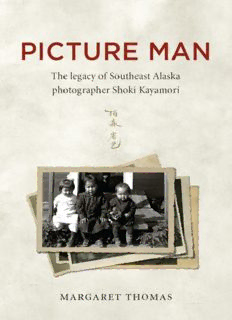
Picture Man: The Legacy of Southeast Alaska Photographer Shoki Kayamori PDF
Preview Picture Man: The Legacy of Southeast Alaska Photographer Shoki Kayamori
PICTURE MAN The Legacy of Southeast Alaska Photographer Shoki Kayamori MARGARET THOMAS University of Alaska Press © 2015 University of Alaska Press All rights reserved University of Alaska Press P.O. Box 756240 Fairbanks, AK 99775-6240 Library of Congress Cataloging-in-Publication Data Thomas, Margaret, 1959– Picture Man : the legacy of southeast Alaska photographer Shoki Kayamori / by Margaret Thomas. pages cm Includes bibliographical references and index. ISBN 978-1-60223-245-7 (paperback) — ISBN 978-1-60223-246-4 (electronic) 1. Kayamori, Shoki, 1877–1941. 2. Japanese American photographers—Alaska—Biography. 3. Photographers—Alaska—Biography. 4. Japanese Americans—Alaska—Biography. 5. Immigrants—Alaska —Biography. 6. Japanese Americans—Alaska—Social conditions—20th century. 7. Alaska—Race relations—History—20th century. 8. Tlingit Indians—Alaska—Yakutat—Social life and customs—20th century—Pictorial works. 9. Yakutat (Alaska)—Social life and customs—20th century—Pictorial works. 10. Documentary photography—Alaska—History—20th century. I. Title. TR140.K38T46 2015 770.92—dc23 [B] 2014023690 Cover design by Martyn Schmoll Interior design by Publishers’ Design and Production Services, Inc. This publication was printed on acid-free paper that meets the minimum requirements for ANSI /NISO Z39.48—1992 (R2002) (Permanence of Paper for Printed Library Materials). CONTENTS Acknowledgments Introduction CHAPTER ONE Meiji Japan CHAPTER TWO The West Coast CHAPTER THREE The Aokis CHAPTER FOUR Cannery Life CHAPTER FIVE Yakutat CHAPTER SIX Spies CHAPTER SEVEN The Kayamori Collection Notes Bibliography Index ACKNOWLEDGMENTS Writing a book seems like a solitary effort. It is not. My friend Larry Persily, then editor at the Juneau Empire, first introduced me to Shoki Kayamori in the mid-1990s. The paper ran a weekly column called “Juneau Color,” which spotlighted community members engaged in good works. I guess Larry was out of ideas. He joked that mine would be the first “Juneau Color” about a dead man. Twenty years later I sent him the first chapter of this book. He gave me the courage to go on to the next chapter. And the next. Some of Kayamori’s history was hidden behind a language barrier. As a high school exchange student, I spent a year with a wonderful Japanese family, but my grasp of the language remains rudimentary. It was my friend Mayumi Yamamoto who unlocked the story of the photographer’s early life in Japan. A talented researcher and translator, Mayumi quickly located the Kayamori family in central Japan. The next time she went home to visit her own family she interviewed the Kayamoris on my behalf. An elderly great-niece wept and thanked her for bringing them news of a long-lost family member. The Kayamoris cleared up confusion about the photographer’s first name. The people in Yakutat knew him simply as Kayamori. His first name appeared in Frederica de Laguna’s book Under Mount Saint Elias, probably based on interviews with Yakutat residents less than a decade after his death. She transcribed the name as Fhoki, a letter combination that does not exist in Japanese. The Kayamoris provided a family tree that showed his first name as Seiki. The same kanji can be read Shoki, a nickname he often used on official documents. Mayumi’s success motivated me to return to Alaska for another look at the Kayamori collection, which was not yet entirely online. Serendipitously, I met the head of Alaska State Library’s Historical Collections, Jim Simard, who has from that day on unflinchingly supported this project. His positive comments about the manuscript and his offer to donate some seventy images from the collection were instrumental in the University of Alaska Press’s decision to publish this book. Though I have never met him, UA Press acquisitions editor James Engelhardt can expect a hug if I ever do. He took a chance on an unpublished writer with a half-finished manuscript and guided me through the two-year process from inception to publication. His instincts about how to improve the text always did. Without the two James’s backing, I could not have gotten generous grants from King County 4Culture and the Alaska Humanities Forum, or a dozen more Kayamori images from the Sealaska Heritage Institute. All of these built the momentum necessary to convince South Puget Sound Community College to give me a paid sabbatical to finish the book. Support from strangers is always surprising and gratifying, but my mother Hilda Merrick’s interest in this project and the improvements she made to portions of the text will always matter most to me. Thanks, Mom. Finally, writing a book is for long stretches a solitary effort. One thing that helped me stay at the desk was knowing that my sweet, cheerful husband would be home at the end of each day. A more gifted writer than I, Ralph read the manuscript and saved me the embarrassment of typos and other errors. He celebrated with me many minute milestones, and sent a bouquet when the publisher finally officially approved this project. The card read, “Your persistence is inspiring.” His love and unwavering support made that possible— even fun. Note: Only those photographs from the Alaska State Library Historical Collection and from the Sealaska Heritage Institute (tagged with a (K) throughout this book) were taken by Shoki Kayamori. The four images where he is pictured presumably were taken with a self-timer or by someone else using his camera.
Description: